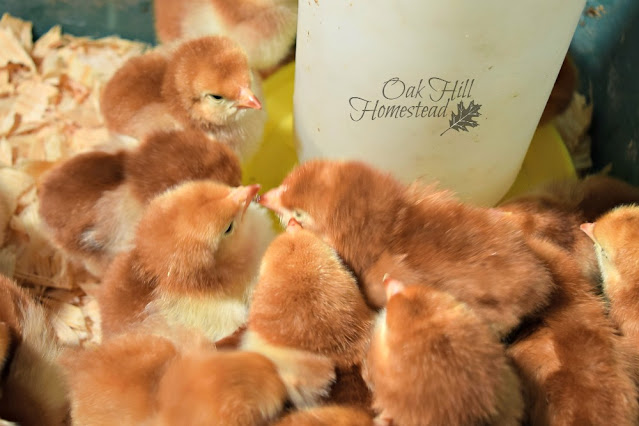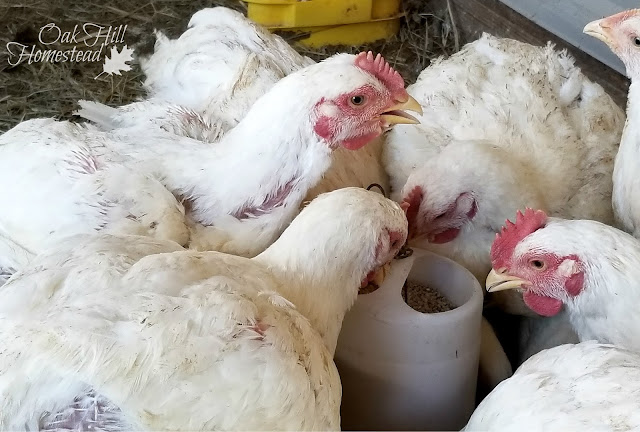A comparison of Cornish Cross meat chickens and heritage breed chickens raised for the freezer. You'll learn the advantages and disadvantages of raising dual-purpose chickens to butcher age, and see how they compare to "broilers" which are bred specifically for meat.
A comparison of heritage breed chickens and broilers (Cornish Cross)
Before we moved to Oak Hill, we lived about fifteen minutes from a custom poultry processor in Michigan.
We took two batches of chickens to this processor to be butchered. The first time we took the roosters from our straight-run order of black Australorps, and the second time we had a batch of Cornish Cross broilers.
We didn't know how blessed we were to be so close to such a resource until we moved away from it.
The nearest processor to our new homestead was several hours away. As much as we wanted to continue raising chickens for our freezer and table, we stuck with laying hens only for several years.
Eventually though, a poultry processor opened a bit closer to home. Not as close as we had in Michigan, but less than two hours away.
We were excited about the thought of raising meat again.
Heritage breed chickens
This spring I was given 25 straight-run Rhode Island red chicks for free in a hatchery giveaway. I was thrilled to add them to my flock, to say the least.
They were straight-run, of course, which means that the chicks were a mix of male and female. In a batch of straight-run chicks, you get roughly 50% male and 50% female chicks.
I didn't need so many roosters, of course, so we planned to send the young roosters ("cockerels") to the poultry processor when they were big enough.
On the duly appointed date, we took ten five-month-old cockerels to their appointment.
Heritage breeds such as the Rhode Island reds are much different from the packaged chicken you bring home from the grocery store.
Even the so called "dual-purpose" breeds - those that are supposed to be good producers of both eggs and meat - aren't the same as bred-for-the-table birds.
While some folk say that those white "Frankenstein" chickens that are grown solely for meat are genetically modified (GMO), they aren't - they're simply bred for super-fast growth.
Let's be honest, chickens reach maturity between four and six months of age, and their eggs hatch after just 21 days, so it doesn't take long at all to see the results of your breeding plans. Several generations of birds can be tracked within a relatively short period of time.
Compare that to goats, cows and horses (not to eat, of course!), where you have to invest several years before an animal is old enough to be bred, carries the baby to birth, and the next generation grows up to be bred again.
It takes much longer to evaluate the results of your breeding program and to change the characteristics of large mammals.
The neatly-packaged chicken you bring home from the grocery store are usually white chickens called Cornish cross or Cornish Rock cross.
These birds are a cross between the white Cornish and White Rock breeds. Some hatcheries might give them a different name, but they are basically the same birds.
Our Rhode Island red cockerels, and other dual-purpose breeds like them, take longer to reach butcher size. They are a bit tougher to eat, but they are still very good.
They are best cooked slow and moist: stewed on the stove-top, cooked in the slow cooker or pressure cooker. I'm told they are very good in the smoker too.
Aside from taste and texture, one of the biggest differences between heritage breeds and Cornish cross chickens is the amount of time it takes to grow them out.
Heritage breeds take about five months to reach butcher size, while Cornish cross birds are ready to butcher at about 8-10 weeks of age.
You read that right. Just weeks. Cornish cross are ready to butcher in two or two-and-a-half months.
Basically the heritage breeds take roughly twice as long to grow out, which means they require approximately twice as much feed and twice as much labor.
You can free-range your heritage birds so that they're foraging for some of their food as well as earning their keep by eating bugs, but you're still feeding them twice as long as the Cornish cross chicks.
The Cornish cross chickens aren't interested in exercise and aren't good foragers. They like to wait in front of the feeders until you bring them more feed.
We don't have running water near the poultry coops, so I had to carry water to the Rhode Island reds for twice as long as I did to the Cornish cross.
Since the Cornish cross chicks tend to stand in front of the feeders all day long and eat, eat, and eat some more, they also produce a great deal more droppings. I find their droppings to be much wetter, heavier and smellier.
Their coop needs to be cleaned much more often. On the other hand, there's a greater quantity of droppings to add to the compost pile too.
Cornish cross birds are likely to have leg problems because they are so heavy. They are also prone to heart attacks for the same reason.
Meat birds will give you a greater yield after butchering. I compared the final weight of our Rhode Island reds with our Cornish cross chickens in another post, Raising Cornish Cross Chickens.
In comparison:
Heritage breeds:
- take 4-5 months to reach butcher size
- have tougher meat
- produce less meat
- must be fed for a longer period of time
- are better foragers
Cornish Cross:
- reach butcher size in just 8-10 weeks
- produce tender meat
- are heavier/meatier
- consume more feed
- aren't good foragers
- produce wetter droppings in greater quantity; it's harder to keep them clean
- are smelly
So, is one type of chicken better to raise for meat than the other?
They both have their pros and cons, and the final decision is up to you.
You might prefer to incubate your layer hens' eggs and process the extra rooster chicks when they are old enough, or you might want to buy Cornish cross chicks and raise a year's supply of meat at once.
You'll find all of my chicken-raising and chicken-keeping posts here. For even more homesteading and self-reliant information and inspiration, subscribe to The Acorn, Oak Hill Homestead's weekly-ish newsletter, and follow me on Facebook, Instagram and Pinterest. I'd love to see you there!
~~~~~
My hope is to inspire you, and to encourage your homesteading plans and your dreams of a simple, self-reliant, God-dependent life. You can join me at:
Facebook | Pinterest | Instagram | Subscribe

















